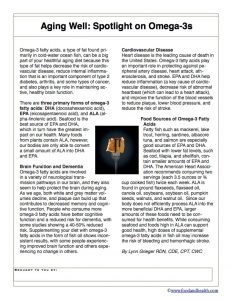Aging Well: Spotlight on Omega-3s
Omega-3 fatty acids, a type of fat found primarily in cold-water ocean fish, can be a big part of your healthful aging diet because this type of fat helps decrease the risk of cardiovascular disease, reduce the internal inflammation that is an important component of type 2 diabetes, arthritis, and some types of cancer, and also plays a key role in maintaining active, healthy brain function.There are three primary forms of omega-3 fatty acids: DHA (docosahexaenoic acid), EPA (eicosapentaenoic acid), and ALA (alpha-linolenic acid). Seafood is the best source of EPA and DHA, which in turn have the greatest impact on our health. Many foods from plants contain ALA, however, our bodies are only able to convert a small amount of ALA into DHA and EPA.Brain Function and DementiaOmega-3 fatty acids are involved in a variety of neurological transmission pathways in our brain, and they also seem to help protect the brain during aging. As we age, both white and grey matter volumes decline, and plaque can build up. This plaque contributes to decreased memory and reduced cognitive function. People who consume more omega-3 fatty acids have better cognitive function and a reduced risk for dementia, with some studies showing a 40-50% reduced risk. Supplementing your diet with omega-3 fatty acids in the form of fish oil shows inconsistent results, with some people experiencing improved brain function and others experiencing no change.Cardiovascular DiseaseHeart disease is the leading cause of death in the United States. Omega-3 fatty acids play an important role in protecting against peripheral artery disease, heart attack, atherosclerosis, and stroke. EPA and DHA help reduce inflammation (a key cause of cardiovascular disease), decrease risk of abnormal heartbeat (which can lead to a heart attack), and improve the function of the blood vessels to reduce plaque, lower blood pressure, and reduce the risk of stroke.Food Sources of Omega-3 Fatty AcidsFatty fish such as mackerel, lake trout, herring, sardines, albacore tuna, and salmon are especially good sources of EPA and DHA. Seafood with lower fat levels, such as cod, tilapia, and shellfish, contain smaller amounts of EPA and DHA. The American Heart Association recommends consuming two servings (each 3.5 ounces or ¾ cup cooked fish) twice each week. ALA is found in ground flaxseeds, flaxseed oil, canola oil, soybeans, soybean oil, pumpkin seeds, walnuts, and walnut oil. Since our bodies do not efficiently process ALA into the more beneficial DHA and EPA, larger amounts of these foods need to be consumed for health benefits. While consuming seafood and foods high in ALA can support good health, high doses of supplemental omega-3 fatty acids in fish oil may increase the risk of bleeding and hemorrhagic stroke.Caution: Some types of seafood may be high in mercury and other environmental contaminants that can lead to significant health problems. Four of the most commonly eaten fish or shellfish that are low in mercury are shrimp, salmon, pollock, and catfish. Avoid eating shark, swordfish, king Mackerel, or tilefish because they contain high levels of mercury.By Lynn Grieger RDN, CDE, CPT, CWCReferences:eXtension. More About the Differences between ALA and EPA/DHA. http://articles.extension.org/pages/63892/more-about-the-differences-between-ala-and-epadha May 12, 2012. Accessed 12-26-16.Denis I, Potier B, Heberden C, Vancassel S. Omega-3 polyunsaturated fatty acids and brain aging. Curr Opin Clin Nutr Metab Care. 2015 Mar;18(2):139-46.Jackson PA, Pialoux V, Corbett D, Drogos L, Erickson KI,, Eskes GA, Poulin MJ. Promoting brain health through exercise and diet in older adults: a physiological perspective. J Physiol. 2016 Aug 15;594(16):4485-98.Cole GM, Ma Q-L, Frautschy SA. Dietary Fatty Acids and the Aging Brain. Nutrition reviews. 2010;68(0 2):S102-S111.Cutuli D, Pagani M, Caporali P, et al. Effects of Omega-3 Fatty Acid Supplementation on Cognitive Functions and Neural Substrates: A Voxel-Based Morphometry Study in Aged Mice. Frontiers in Aging Neuroscience. 2016;8:38. doi:10.3389/fnagi.2016.00038.Centers for Disease Control and Prevention. National Center for Health Statistics. https://www.cdc.gov/nchs/fastats/leading-causes-of-death.htm Last Updated October 7, 2016. Accessed 12-26-16.Swanson D, Block R, Mousa S. Omega-3 Fatty Acids EPA and DHA: Health Benefits Throughout Life. Adv Nutr vol. 3: 1-7, 2012.University of Maryland Medical Center. Omega-3 Fatty Acids. http://umm.edu/health/medical/altmed/supplement/omega3-fatty-acids Last reviewed 8-5-2015. Accessed 12-27-16. American Heart Association. Fish and Omega-3 Fatty Acids. http://www.heart.org/HEARTORG/HealthyLiving/HealthyEating/Nutrition/Fish-and-Omega-3-Fatty-Acids_UCM_303248_Article.jsp#.WGbAgPkrL4c Updated October 6, 2016. Accessed 12-27-16.National Institutes of Health, Office of Dietary Supplements. Omega-3 Fatty Acids. https://ods.od.nih.gov/factsheets/Omega3FattyAcids-HealthProfessional/ Updated 2-22-2016. Accessed 12-26-16.https://www.ncbi.nlm.nih.gov/pmc/articles/PMC4404917/Adult neurogenesis is the process by which new neurons are generated from neural stem cells and progenitor cells. Aging is the greatest negative regulator of neurogenesis Handout:


